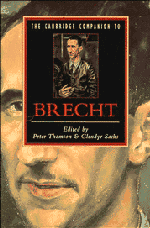Book contents
- Frontmatter
- PART 1 CONTEXT AND LIFE
- PART 2 THE PLAYS
- 3 Brecht's early plays
- 4 The Threepenny Opera
- 5 Brecht's clowns: Man is Man and after
- 6 Learning for a new society: the Lehrstück
- 7 Saint Joan of the Stockyards
- 8 The Zelda syndrome: Brecht and Elisabeth Hauptmann
- 9 The Good Person of Szechwan: discourse of a masquerade
- 10 Mother Courage and Her Children
- 11 Heavenly food denied: Life of Galileo
- 12 The Caucasian Chalk Circle: the view from Europe
- PART 3 THEORIES AND PRACTICES
- Bibliography
- Index of Works
- General Index
4 - The Threepenny Opera
from PART 2 - THE PLAYS
Published online by Cambridge University Press: 28 May 2006
- Frontmatter
- PART 1 CONTEXT AND LIFE
- PART 2 THE PLAYS
- 3 Brecht's early plays
- 4 The Threepenny Opera
- 5 Brecht's clowns: Man is Man and after
- 6 Learning for a new society: the Lehrstück
- 7 Saint Joan of the Stockyards
- 8 The Zelda syndrome: Brecht and Elisabeth Hauptmann
- 9 The Good Person of Szechwan: discourse of a masquerade
- 10 Mother Courage and Her Children
- 11 Heavenly food denied: Life of Galileo
- 12 The Caucasian Chalk Circle: the view from Europe
- PART 3 THEORIES AND PRACTICES
- Bibliography
- Index of Works
- General Index
Summary
The Threepenny Opera is unique. Since its first performance in Berlin, at the Theater am Schiffbauerdamm on 31 August 1928, it has enjoyed a popularity matched only by the best-known Broadway musicals or the most established operas. It has led a protean existence in commercial theatres, in subsidised regional and national theatres and in opera houses. It has spawned a film, a novel and countless recordings of its music by a bewildering range of performers.
Yet it is clearly not an opera in any conventional sense; the word opera in the title implies a parody. Formally the music is too disunited to make it, for its time, a 'proper' opera, even though operatic devices such as recitative, ensembles and choruses are used. Neither is it a musical in the sense that we now accept the term, even though the Marc Blitzstein revival in the 1950s ran in New York for more than 2,500 performances. Successful Broadway musicals tend to have socially conventional plots with plenty of spectacle and picturesque romanticism, not Marxist-inspired social criticism as their motivation.
- Type
- Chapter
- Information
- The Cambridge Companion to Brecht , pp. 56 - 67Publisher: Cambridge University PressPrint publication year: 1994

